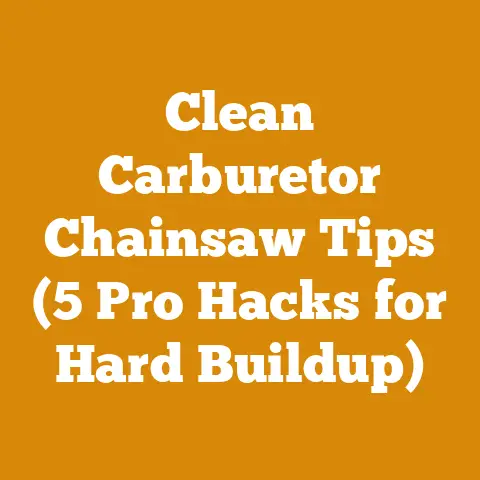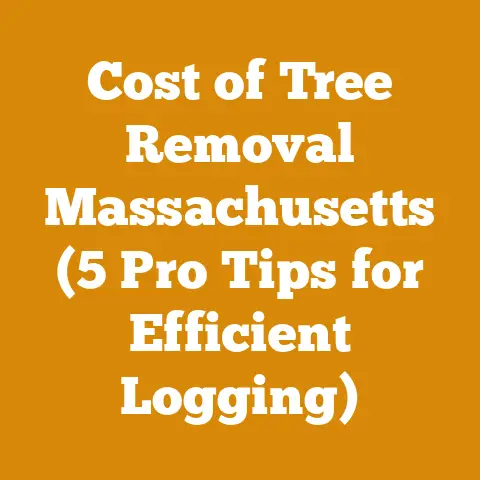Stump Removal Tips (Expert Methods for Efficient Wood Processing)
Stump Removal Tips: Expert Methods for Efficient Wood Processing
Stump removal isn’t just about aesthetics; it’s a crucial step in efficient wood processing. A forgotten stump can be a breeding ground for pests, a tripping hazard, and an obstacle to future landscaping or building projects. My goal is to provide you with the knowledge and techniques to tackle stump removal like a seasoned pro, whether you’re a homeowner, a small-scale logger, or someone simply looking to clear some land.
Understanding the Challenge: Why Are Stumps So Tough?
Before I get into the “how,” let’s understand the “why.” Stumps are tough because they are essentially the base of a tree’s entire root system. This means they are deeply anchored in the ground, often with a network of roots spreading far and wide. The wood itself is dense and seasoned, making it resistant to decay.
- Root System: The root system acts like an underground anchor, making the stump incredibly stable. The size and depth of the roots vary depending on the tree species and soil type.
- Wood Density: The wood near the base of the tree is often the oldest and densest, making it harder to cut or break down.
- Seasoning: Over time, the stump wood dries out, becoming even tougher.
Assessing the Stump: The First Step to Success
Before you even think about picking up a tool, take the time to assess the stump. This will help you determine the best removal method and the tools you’ll need.
- Size: How big is the stump? Measure the diameter at its widest point. This will give you an idea of the scale of the project.
- Species: What kind of tree was it? Different species have different root systems and wood densities. For instance, oak and maple are notoriously tough, while pine and poplar are generally easier to deal with.
- Location: Where is the stump located? Is it near any utilities or structures? This will influence your choice of removal method.
- Age: How long has the stump been there? Older stumps may be partially decayed, making them easier to remove.
Manual Stump Removal: The Sweat Equity Approach
For smaller stumps, or when you want to avoid the noise and expense of machinery, manual removal is a viable option. It’s definitely a workout, but it can be satisfying.
Tools You’ll Need:
- Shovel: A sturdy shovel is essential for digging around the stump and exposing the roots.
- Axe: A good axe is needed to chop through smaller roots.
- Mattock: A mattock is a versatile tool with an axe blade on one side and a pick on the other. It’s great for digging and prying.
- Bow Saw or Pruning Saw: For cutting roots that are too thick for the axe.
- Root Saw: A specialized saw designed for cutting through roots underground.
- Gloves: Protect your hands from blisters and splinters.
- Safety Glasses: Protect your eyes from flying debris.
Step-by-Step Guide:
- Clear the Area: Remove any rocks, debris, or vegetation around the stump.
- Dig Around the Stump: Use the shovel to dig a circle around the stump, exposing the roots. Aim to dig down at least 12-18 inches.
- Cut the Roots: Use the axe, mattock, bow saw, or root saw to cut through the exposed roots. Start with the smaller roots and work your way up to the larger ones.
- Wiggle and Pry: Once you’ve cut through most of the roots, try wiggling the stump back and forth. Use the mattock or a pry bar to help loosen it.
- Remove the Stump: With enough wiggling and prying, the stump should eventually come loose. You may need to cut a few more roots to free it completely.
- Fill the Hole: Once the stump is removed, fill the hole with soil and compact it.
My Personal Experience:
I remember one particularly stubborn oak stump I tackled manually. It was in a tight spot near a fence, so I couldn’t use any heavy machinery. It took me a full day of digging, chopping, and prying, but the feeling of finally getting that stump out of the ground was incredibly rewarding.
Tips for Success:
- Sharpen Your Tools: Sharp tools make the job much easier and safer.
- Work in Sections: Focus on one section of roots at a time.
- Take Breaks: Manual stump removal is hard work. Don’t overdo it.
- Use Leverage: A pry bar or a long piece of wood can provide extra leverage when prying the stump loose.
Chemical Stump Removal: The Patient Approach
If you’re not in a hurry and prefer a less physically demanding method, chemical stump removal might be the way to go. This involves using chemicals to accelerate the natural decomposition process.
Chemicals You’ll Need:
- Potassium Nitrate (Stump Remover): This is the most common chemical used for stump removal. It speeds up the decay process.
- Epsom Salts: Can be used as a natural alternative, but it takes longer.
Step-by-Step Guide:
- Drill Holes: Using a drill with a large drill bit (1/2 inch or larger), drill several holes into the stump. Drill as deep as possible, and space the holes a few inches apart. Focus on drilling into the sides of the stump as well as the top.
- Fill the Holes: Fill the holes with the stump remover or Epsom salts.
- Add Water: Pour water into the holes to help dissolve the chemicals.
- Cover the Stump: Cover the stump with a tarp or plastic sheet to keep it moist and prevent rain from washing away the chemicals.
- Wait: This is the hard part. It can take several weeks or even months for the stump to decompose. The exact time depends on the size of the stump, the type of wood, and the weather conditions.
- Chop and Remove: Once the stump has become soft and spongy, you can chop it up with an axe and remove it.
My Personal Experience:
I used the chemical method on a cluster of small pine stumps in my backyard. It took about three months, but eventually, the stumps became so soft that I could easily chop them up with an axe.
Tips for Success:
- Use a High Concentration: The more chemicals you use, the faster the stump will decompose.
- Keep it Moist: Moisture is essential for the decomposition process.
- Be Patient: This method takes time. Don’t expect overnight results.
- Consider the Environment: Be mindful of the surrounding vegetation and avoid spilling chemicals on nearby plants.
Stump Grinding: The Efficient Solution
Stump grinding is a fast and effective way to remove stumps, especially larger ones. It involves using a specialized machine called a stump grinder to grind the stump into small chips.
Tools You’ll Need:
- Stump Grinder: This is the most important tool for this method. You can rent a stump grinder from most equipment rental companies.
- Safety Glasses: Essential for protecting your eyes from flying debris.
- Hearing Protection: Stump grinders are very noisy.
- Gloves: Protect your hands.
- Shovel: For clearing away the wood chips.
- Rake: For leveling the ground.
Step-by-Step Guide:
- Clear the Area: Remove any rocks, debris, or vegetation around the stump.
- Position the Stump Grinder: Position the stump grinder so that the grinding wheel is directly over the stump.
- Start Grinding: Start the engine and slowly lower the grinding wheel onto the stump. Move the grinder back and forth and side to side to grind the stump down to the desired depth (usually 4-6 inches below ground level).
- Grind the Roots: Grind any exposed roots that are connected to the stump.
- Fill the Hole: Once the stump is ground down, fill the hole with the wood chips and soil. Compact the soil and level the ground.
My Personal Experience:
I once had to remove a massive maple stump that was over 3 feet in diameter. I rented a stump grinder for the day, and it made the job so much easier. It took me a few hours, but the stump was completely gone, and the area was ready for replanting.
Tips for Success:
- Read the Manual: Before operating a stump grinder, read the manual carefully and understand all the safety precautions.
- Wear Safety Gear: Always wear safety glasses, hearing protection, and gloves when operating a stump grinder.
- Start Slow: Start grinding slowly and gradually increase the pressure.
- Avoid Rocks: Rocks can damage the grinding wheel.
- Call a Professional: If you’re not comfortable operating a stump grinder, hire a professional.
Burning Out a Stump: The Controlled Fire Approach
Note: Burning stumps is illegal or requires permits in many areas. Check your local regulations before attempting this method.
Burning out a stump is a traditional method that involves creating a fire inside the stump to burn it away. It’s a slow process, but it can be effective.
Tools You’ll Need:
- Drill: For drilling holes in the stump.
- Kerosene or Diesel Fuel: To help start the fire.
- Firewood: To fuel the fire.
- Shovel: To control the fire and remove ashes.
- Water Hose: To extinguish the fire if necessary.
- Safety Glasses: Protect your eyes.
- Gloves: Protect your hands.
Step-by-Step Guide:
- Drill Holes: Drill several holes into the stump, as deep as possible.
- Soak with Fuel: Pour kerosene or diesel fuel into the holes to help start the fire.
- Start the Fire: Place firewood around the stump and light it.
- Maintain the Fire: Keep the fire burning by adding more firewood as needed.
- Control the Fire: Use the shovel to control the fire and prevent it from spreading.
- Extinguish the Fire: Once the stump has burned down to the ground, extinguish the fire with water.
- Fill the Hole: Fill the hole with soil and compact it.
My Personal Experience:
I used the burning method on a small pine stump in a remote area where it was legal and safe to do so. It took several days of tending the fire, but eventually, the stump was completely gone.
Tips for Success:
- Check Local Regulations: Make sure it’s legal to burn stumps in your area.
- Choose a Safe Location: Burn stumps in a clear area away from trees, buildings, and other flammable materials.
- Have Water Ready: Keep a water hose nearby in case the fire gets out of control.
- Never Leave the Fire Unattended: Always supervise the fire.
Natural Decomposition: The Hands-Off Approach
If you’re patient and don’t mind waiting, you can let nature take its course. Over time, the stump will naturally decompose.
How to Speed Up the Process:
- Keep it Moist: Water the stump regularly to encourage decay.
- Add Nitrogen: Nitrogen-rich materials, such as compost or manure, can speed up the decomposition process.
- Cover with Soil: Covering the stump with soil will help retain moisture and provide a favorable environment for decomposers.
- Mushroom Inoculation: Inoculating the stump with mushroom spores can accelerate the decay process.
My Personal Experience:
I had a small birch stump in my backyard that I decided to let decompose naturally. I kept it watered and covered with leaves, and after about two years, it had almost completely disappeared.
Tips for Success:
- Be Patient: This method takes time.
- Provide Moisture: Moisture is essential for decomposition.
- Add Nitrogen: Nitrogen helps accelerate the process.
- Consider Mushroom Inoculation: This can speed things up significantly.
Excavation: The Heavy Equipment Solution
For very large stumps, or when you need to remove a stump quickly, excavation is the best option. This involves using heavy equipment, such as a backhoe or excavator, to dig around the stump and pull it out of the ground.
Tools You’ll Need:
- Backhoe or Excavator: This is the main tool for this method.
- Chainsaw: To cut any roots that are too thick to pull out.
- Shovel: To clear away soil.
Step-by-Step Guide:
- Clear the Area: Remove any rocks, debris, or vegetation around the stump.
- Dig Around the Stump: Use the backhoe or excavator to dig a wide circle around the stump, exposing the roots.
- Cut the Roots: Use the chainsaw to cut any roots that are too thick to pull out.
- Lift the Stump: Use the backhoe or excavator to lift the stump out of the ground.
- Fill the Hole: Fill the hole with soil and compact it.
My Personal Experience:
I once had to remove a giant oak stump that was over 5 feet in diameter. I hired a professional with an excavator, and they had the stump out of the ground in less than an hour.
Tips for Success:
- Hire a Professional: Operating heavy equipment requires skill and experience.
- Call Before You Dig: Before digging, call your local utility companies to locate any underground lines.
- Be Careful: Heavy equipment can be dangerous.
- Consider the Impact: Excavation can disrupt the surrounding soil and vegetation.
Choosing the Right Method: A Decision Guide
With so many options, how do you choose the right stump removal method for your situation? Here’s a decision guide to help you decide:
- Stump Size:
- Small Stumps (less than 1 foot in diameter): Manual removal, chemical removal, or natural decomposition.
- Medium Stumps (1-3 feet in diameter): Stump grinding, manual removal (with effort), or burning (if legal and safe).
- Large Stumps (over 3 feet in diameter): Excavation or stump grinding (by a professional).
- Time:
- Need it gone quickly: Stump grinding or excavation.
- Can wait: Chemical removal or natural decomposition.
- Effort:
- Want to avoid physical labor: Chemical removal, stump grinding (hire a professional), excavation (hire a professional), or natural decomposition.
- Willing to work: Manual removal or burning (if legal and safe).
- Budget:
- Tight budget: Manual removal, chemical removal, or natural decomposition.
- More flexible budget: Stump grinding or excavation.
- Location:
- Close to utilities or structures: Avoid excavation and burning.
- Remote location: Burning may be an option (if legal and safe).
- Environmental Concerns:
- Want to minimize environmental impact: Manual removal, natural decomposition, or mushroom inoculation.
- Less concerned: Chemical removal or burning (if legal and safe).
Safety First: Protecting Yourself and Others
No matter which stump removal method you choose, safety should always be your top priority.
- Wear Safety Gear: Always wear safety glasses, hearing protection, gloves, and sturdy boots.
- Read the Manuals: Before operating any equipment, read the manual carefully and understand all the safety precautions.
- Call Before You Dig: Before digging, call your local utility companies to locate any underground lines.
- Be Aware of Your Surroundings: Watch out for other people, animals, and obstacles.
- Use Caution: Never take unnecessary risks.
- Stay Sober: Never operate equipment under the influence of alcohol or drugs.
- First Aid Kit: Keep a well-stocked first aid kit nearby.
After Stump Removal: Reclaiming Your Space
Once the stump is gone, it’s time to reclaim your space.
- Fill the Hole: Fill the hole with soil and compact it.
- Level the Ground: Level the ground with a rake.
- Replant: Replant grass, flowers, or trees.
- Consider the Soil: If the soil is compacted or nutrient-poor, amend it with compost or other organic matter.
- Enjoy Your New Space: Now you can enjoy your stump-free yard!
Advanced Wood Processing for Firewood
Now that you’ve dealt with the stump, let’s talk about turning the rest of the tree into firewood. Efficient wood processing is key to maximizing your yield and minimizing your effort.
Timber Grading: Knowing Your Wood
Before you start cutting, it’s important to understand timber grading. This refers to the quality and characteristics of the wood, which will affect its suitability for different uses.
- Grade 1: Clear, knot-free wood. Ideal for furniture and fine woodworking.
- Grade 2: Some knots and imperfections. Suitable for general construction and firewood.
- Grade 3: Many knots and imperfections. Best for firewood or rough construction.
Chainsaw Selection: The Heart of Wood Processing
The chainsaw is your primary tool for wood processing. Choosing the right chainsaw is crucial for efficiency and safety.
- Gas Chainsaws: Powerful and portable. Ideal for larger trees and remote locations.
- Electric Chainsaws: Quieter and lighter. Suitable for smaller trees and urban environments.
- Battery-Powered Chainsaws: A good compromise between gas and electric.
- Bar Length: Choose a bar length that is appropriate for the size of the trees you’ll be cutting.
- Safety Features: Look for chainsaws with safety features such as chain brakes and anti-vibration systems.
Sawmill Operations: From Log to Lumber
If you have access to a sawmill, you can turn logs into lumber for various projects.
- Portable Sawmills: Allow you to mill lumber on-site.
- Commercial Sawmills: Offer professional milling services.
Splitting Techniques: Taming the Logs
Splitting wood is an essential step in preparing firewood.
- Manual Splitting: Using an axe or maul. A good workout, but can be tiring.
- Hydraulic Log Splitters: Make splitting wood much easier and faster.
- Kinetic Log Splitters: Even faster than hydraulic splitters.
Wood Drying Processes: Seasoning for Efficiency
Seasoning wood is crucial for efficient burning.
- Air Drying: The most common method. Stacking wood in a well-ventilated area for 6-12 months.
- Kiln Drying: A faster method, but requires specialized equipment.
Safety Procedures: Chainsaws and Log Splitters
Operating chainsaws and log splitters can be dangerous. Always follow these safety procedures:
- Wear Safety Gear: Safety glasses, hearing protection, gloves, and sturdy boots.
- Read the Manuals: Understand the equipment and safety precautions.
- Maintain Your Equipment: Keep your chainsaw and log splitter in good working order.
- Stay Focused: Avoid distractions.
- Never Work Alone: Have someone nearby in case of an emergency.
Conclusion: Mastering Stump Removal and Wood Processing
Stump removal and wood processing can be challenging, but with the right knowledge and techniques, you can tackle these tasks safely and efficiently. Remember to assess the situation, choose the appropriate method, prioritize safety, and enjoy the satisfaction of a job well done. As I always say, a little sweat equity is good for the soul, especially when it leads to a warm fire on a cold winter’s night. Now, get out there and make some sawdust!






